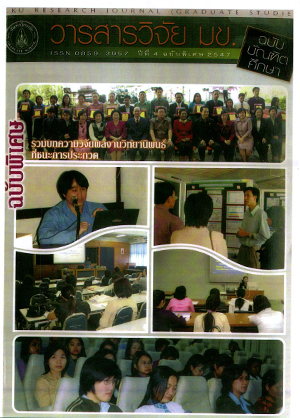ประสิทธิภาพของสารสกัดผักเม็กในการลดภาวะ ออกซิเดชันในหนูทดลองรีโมลัยติดอะนีเพีย(Efficacy of Eugenia Grata Extract in Reduction of Oxidative Damage in Hemolytic Anemic Rats)
Keywords:
Phenylhydrazine, Eugenia grata, antioxidantAbstract
สาร Phenylhydrazine (PHZ) เป็นสารที่ทVIห้เกิดฮีโมลัยติคอะนีเมียในสัดวัทดลองไดยทำปเ]กิรีย1กับ โมเลกุลของฮีโมโกลบนและซกนำให้เกิดภาวะเครียดจากออกซิเดชันส่งผลให้ระบบการไหลเวียนเสีอดล้มเหลว
นอกจากนั้นหนูทดลองที่ได้รับสาร PHZ จะแสดงภาวะความดันเลือดและความด้านทานหลอดเลือดตํ่า และ ลดการตอบสนองของหลอดเลือดต่อสารที่พีผลโาบหลอดเลือดซึ่งอาจมีสาเทตุจากการลดลงซองระบบ ^นออกซิเดชนภายในร่างกาย ในปัจจุบัน’ได้มีการทดสอหพบว่าผักพื้น'บ้า'นขอ-งไ,ทยมีฤทธด้านออก;ซิแด,ชัน'ทดี ดังนั้นวัตถุประสงค์ซองการวิวัยในครั้งนี้เพื่อคักบาร่า สารสกัดผักเม็ก (Eugenia grata) สามารถลดภาวะเครียด จากออกซิ,เดชันที่เกิดขึ้น1ไนหนูทดลอง ที่ถูกชักนำให้ภิดรีไมลัยติดอะมีเมียด้วยสาร PHZ ได้ การศึกษาวิวัยทำได้ โดยการป้อนสารสกัดผักเม็กขนาด 1 กรัม/กก/วัน เป็นเวลา 6 วันและในวันที่ 4 ของการทดลองหนูทดลอง จะถูกชักนำให้เกิดรีโมลัยติคอะนีเมียด้วยการฉีดสาร PHZ ยบ''ด 125 มก-/กก* เด้าทรงช่องท้อง เบื่อครบ กำหนด 6 วันจะทำการเก็บตัวอย่างเลือดเพื่อวัดค์ารีมาโดดรีด และกถูทา’ไทออน ส่วนตัวอย่างพลาสมา จะตรวจวัดปริมาณ nitric oxide metabolites (NOx) จากนั้นหนูทดลองจะถูกทำให้สลบและทำการวัดค่าความดันเลือด อตรกํกํกํรํไหลเวียนเลือดซองอวัยวะท่อนล่างและอัตราการ^นของดัวใจ ผ่าน BIOPAC System ผลการทดลอง พบว่าเมื่อให้สาร PHZ ความดันเลือด และระดับกลูทาไทออนในเลือดลดสงอย่างมีนัยสำคัญ ส่วนปรีมากเ NOx เพิ่มขึ้นเกือบสองเท่าเมื่อเปรียบเทียบกับ'หนูปกติ (p<0.05) แม้ว่าการให้สารสกัดผักเม็กจะไม่สามารกปองกน การเกิดรีโมลัยติคอะนีเมีย ได้แต่สกานภาพการไหลเวียนกเลือดและระบบด้านออกซิเด ด้านภายในร่างกายของหนู ทดลองกลุ่มนี้ดีขึ้นอย่างมีนัยสำคัญเมื่อเปรียบเทียบกับหนูช่ดกลุ่มควบคุมโดยสใ'ปเกลัวสารสกัดผั1กเม็กให้1แล ลดภาวะเครียดจากออกซิเดชัน ทาให้การใช้สารด้านออกซิเดชันภายในร่างก^ยลดลงละทีผลเพื่มตวามคันเสี®ด แดงเพอัปรับสภาพระบบการ'ไหลเวียนเลือด,ยอง'หโ!'ทดลอง1ปีไมลัยติคอะบีเมียใหดซึ่บ ซึ่งอาจเป็นแนวุทางใบ กา-รนา-ผกพน'บกํน’ไป'ประยุกตัเซในการลดภาวะเครียด’จาก!ออ!กช่เ,ดด้นัไนภาวะรีโมลัยติดอะบีเมียใบ1ผันั'รยต่อไบี
Phenylhydrazine (PHZ) is the oxidative drug that induced hemolytic anemia in experimental animals by interaction with hemoglobin at which leads to the oxidative stress and consequently circulatory failure. Moreover, the PHZ-treated rats exhibited hypotension, low systemic vascular resistance and decreased vascular responses to endothelium-dependent vasodilator agents. The attenuation of vascular responses in these conditions may be due to a decrease in the antioxidant defense. Recently, our preliminary work has demonstrated that a local vegetable, Eugenia grata (EG), possessed strong antioxidant activities in many assay systems. Therefore, the aim of this study was to determine whether the EG extract would alleviate PHZ-induced oxidative damage in animal model of hemolytic anemia. Male Sprague-Dawley rats were orally administered with EG extract (1 g/kg/day) for six days while rats in the control group were fed with deionized water. On the fourth day of treatments, animals were induced hemolysis by intraperitoneal injection of 125 mg/kg PHZ. After 48 hours of PHZ administration, blood samples were collected from tail vein for reduced glutathione (GSH) and nitric oxide metabolites (NOx) assays, then animals were anesthetized and measured mean arterial pressure (MAP), and hindlimb blood flow (HBF). PHZ administration resulted in marked hypotension together with significant reduction in blood level of GSH and a twofold increase in plasma NOx. Although EG extract could not protect the animals from hemolytic anemia, a prompt recovery of blood pressure and increasing of antioxidant defense system was found in animals treated with EG extract. As a result, the EG-treated animals exhibited increased blood pressures, increased blood level of GSH and decreased plasma NOx when compared to the anemic control rats (p<0.05). In view of hemodynamic, MAP and hindlimb vascular resistance (HVR) of the anemic rats treated with EG were significantly increased whereas HBF was significantly decreased (P < 0.05). Our findings suggest that EG extract has an antioxidant effect to abrogate sustained hypotension and reverse the abnormal oxidative processes that may contribute to the development of hemolytic anemia, and offer a potential clinical means to alleviate the oxidative damage to the red cells of the hemolytic anemic patients.



